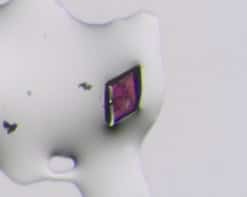

Structural colours are not produced by chemical dyes and pigments but come from resonant interactions between visible light and engineered nanostructures. These colours do not fade over time either, the way ink does. A team of researchers in Barcelona has now developed a soft nanoimprinting lithography technique to fabricate sub-micron photonic architectures in a cellulose derivative that produce such structural colours. The photonic crystals, which are biocompatible and biodegradable, might be used in disposable, washable or edible sensors and labels for the food or medical industry, as well as in packaging, decorative paper and anti-counterfeiting technology.
Structural colouration works thanks to nanoscale pillar-like metallic or dielectric hybrid structures that reflect visible light at different wavelengths. Such structures are also found in nature (for example, in green-winged teal feathers and in some butterfly wings) and are known as photonic crystals. These crystals are nanostructured materials in which periodic variations of the refractive index on the length scale of visible light produces a photonic “band gap”. This gap affects how photons propagate through the material with light of certain wavelength ranges being able to pass through while light in other ranges is reflected.
Researchers led by Agustin Mihi at the Institute of Materials Science of Barcelona (ICMAB-CSIC) have now succeeded in creating 2D photonics crystals of a cellulose derivative, hydroxypropyl cellulose (HPC), with submicron features by periodically nanostructuring a film of the material using soft lithography, a roll-to-roll compatible technique.
Nanostructures display a wide range of bright colours
“Hydroxypropyl cellulose is a white powder that becomes transparent when it is dispersed in water,” explains Mihi. “We made transparent films of this material in water and then by gently pressing and heating it with a pre-patterned mould, produced nanostructures in the film capable of displaying a wide range of bright colours.” The colour produced depends on the size and shape of the moulded nanostructures.
“These photonic crystals can be nanoimprinted on different substrates to confer photonic properties on surfaces that do not have this property – such as paper, for instance,” he adds. “This means that the material might be used to make photonic ink, for applications in anti-counterfeiting technology, packaging, decorative paper, labels and sensors, to name but a few.”
Cellulose goes plasmonic
And that is not all: when these structures are covered with a thin metal layer (of silver), they become plasmonic, which allows them to produce even brighter colours. These metamaterials might be used as disposable sensors for use in techniques such as Raman emission spectroscopy or to increase the intensity of light emitted by a dye, says Mihi. Plasmonics is a relatively new branch of photonics that involves compressing light down to the nanoscale by coupling it to the electrons that oscillate collectively at the surface of metals – called surface plasmons (SPPs) – for strongly guiding and manipulating light.
Cellulose (a polysaccharide made up of repeating glucose units) is one of the most abundant polymers on Earth. It can be easily extracted from plants and consists of fibres around 2 to 4 mm long and 2 to 200 microns wide organized in a hierarchical structure. It is interesting for electronics and photonics applications because is it biocompatible and biodegradable.
Reducing plastic production and consumption
Society needs to reduce its production of plastics, estimated at around 320 million tonnes each year, of which only 10% is recycled. And the sooner the better given the enormous amount of waste being generated that is damaging our planet’s ecosystems – both aquatic and terrestrial. Biopolymers such as cellulose could come into their own here. Indeed, researchers have already started looking into nanocellulose for making photonics components for use in chiral electronics, photonics electrodes, anti-reflection coatings in solar cells, flexible substrates for plasmonic sensing and many more.
While the typical arrangement of cellulose microfibres scatters light diffusely (think of the white colour of paper), nanocellulose can instead form compact and transparent films or colourful optically active ones, depending on whether the particles are arranged in an amorphous or crystalline pattern. The structure of the hydroxypropyl cellulose derivative studied by Mihi and colleagues, who detail their work in Nature Photonics doi:10.1038/s41566-018-0152-1, is similar to cellulose but some of the hydroxyl groups of the glucose building blocks are hydroxypropylated.



